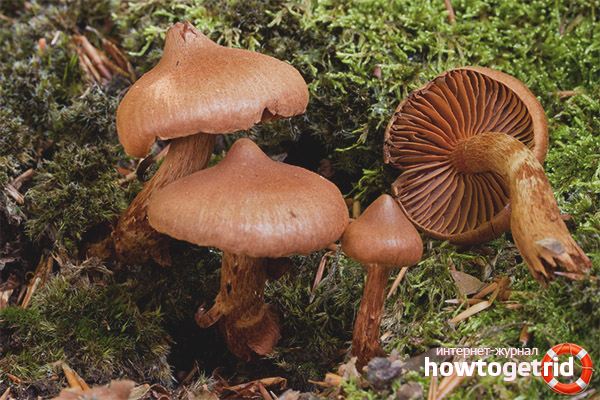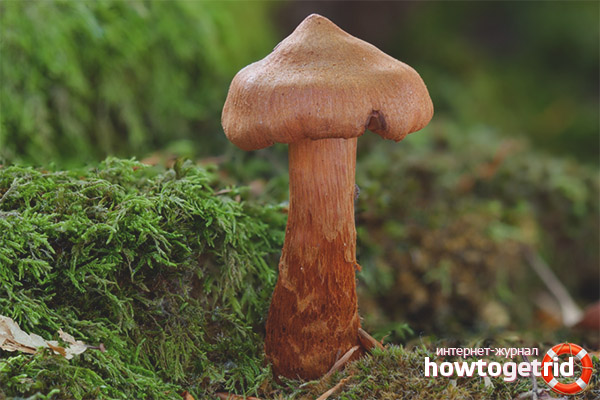The content of the article
By a beautiful cobweb is meant a mushroom that is not edible even after heat treatment. It can be fatal if swallowed. In today's article, we will study everything that affects this variety. We will discuss the territory of growth, as well as provide an external description and other important features. Despite the name, this mushroom is not at all considered the most beautiful member of the family. If you add danger to this characteristic, then you should completely bypass the fruiting bodies of this variety.
Description
- This variety is attributed to the cobweb family and the genus of cobwebs. This fruiting body has another name - a reddish cobweb. It has long been called a bogeyman in common people, but today many have forgotten this name. The mushroom is toxic, poisonous, not suitable for food.
- The apex is thick and medium in size. The diameter reaches 2.5-7.5 cm. According to the format, the apex of young specimens is like a bell. In age-related fruiting bodies, it becomes pillow-shaped with a tubercle in the center.
- The surface of the hat is dry or with small scales. Reddish in color with a brownish tint. It happens orange with red, as well as brown. The final tone depends on the growth environment and age. The features of this fungus include several of its varieties.
- Fruit bodies come with an apex with a darkened middle, from which semicircles extend to the edges. To the lateral parts, the color becomes light, faded. The second variety, on the contrary, is marked by the central light part, which acquires pinkish and red circles to the edges. Spores in the format of spherical with a brown-red tint.
- The base of the fungus is compacted, in the format of a cylinder. It reaches a thickness of 1.5 cm. With a length of up to 12 cm. In the lower section, the leg can become thick, thereby forming a pin format. The base is pigmented orange with brownish. The lower part is painted buffy. The surface of the legs with fibers.
- The soft part is colored orange or yellowish. Taste is absent, this mushroom smells like radish. But in some instances, a characteristic aroma may be completely absent. The plates on the hat grow to the base, are often located, vary in shade from brownish to orange. In mature specimens, the shade changes to a reddish-brown.
Virulence
- As mentioned earlier, the most beautiful cobweb belongs to deadly poisonous fruits. The fungus contains substances in the form of eaglelanins. They cause irreversible changes in the tissues of the kidneys.
- As a result, most often it leads to death. Moreover, such consequences can be encountered six months after the use of such a mushroom, if you suddenly confused it with edible.
Spread
- Often considered fruiting bodies are widely distributed in temperate climates in the northern regions. The beautiful cobweb is very common in Europe, central Russia and the north. Mushroom grows mainly in mixed and coniferous stripes.
- Also, the fruiting body is often found in wet marshy forests. The mushroom prefers acidic soil. In most cases, mycorrhiza forms with firs and birches. The specimen begins to bear fruit from the end of spring until the beginning of autumn. May occur singly or in small groups.
Similar varieties
The fungus under discussion has poisonous and edible relatives, which we will familiarize with below.
- Edible Cobweb. This species is suitable for consumption in food.He has one more name, a spider web is called a fat woman. The top reaches 5-8 cm in diameter, the structure is fleshy and compacted, the edges bend down. In fungi, over time, the upper part becomes depressed and somewhat flat. As for the shade, it is pigmented in white and gray. The skin is moisturized. The height of the specimen is 3 cm. With a thickness of 2 cm. The leg does not bend.
- Mountain spider web. Poisonous variety, dangerous to humans, not suitable for consumption. The hat is 3-8 cm in diameter. Initially, it is raised, but with the course of the life cycle it becomes flat. In the center you can see a hill. The skin is dry, the shade ranges from brown-red to brown-yellow. The base is 2 cm wide and 4 to 9 cm high. The surface of the fungus is with fibers.
- Slime cobwebs. The fruiting body can be attributed to conditionally edible. In addition, such a mushroom should not be confused with a mucous cobweb. These are completely different fruiting bodies. The cap of the fungus in question can grow up to 10-12 cm. In young fruits, it has the shape of a bell. Over time, it becomes flat. In this case, the edges are curves. The color of the hat can be yellowish, brown or brown. A characteristic feature is that such a mushroom is completely covered with mucus. The leg is somewhat similar to a spindle and can reach a height of up to 20 cm. Its color is white with a blue tint. Often on the leg there are rings and lumps.
- Brilliant cobweb. Another fruiting body that is very similar to the mushroom in question. A brilliant cobweb is considered a very poisonous specimen, which leads to death. It is also worth noting that it is quite rare and extremely difficult to detect. It is distinguished by a bright yellow color of the hat. At the same time, it is covered with mucus. Often, the fruiting body grows in coniferous forests.
- Other similar varieties. The most beautiful cobweb belongs to deadly poisonous fruits. However, there are several other types of edible specimens with which it can be confused. For example, camphor lactarius, crimson hygrophor and armillaria glubnyeva (type of honey worm) can be distinguished among those.
The most beautiful cobweb has deadly poison, which acts very slowly on the human body. After some time, kidney failure begins to develop. Signs of poisoning can be dryness and burning in the mouth, thirst.
Video: 10 most poisonous mushrooms











Submit